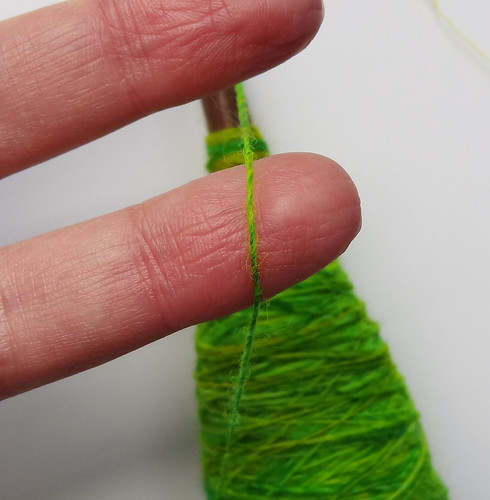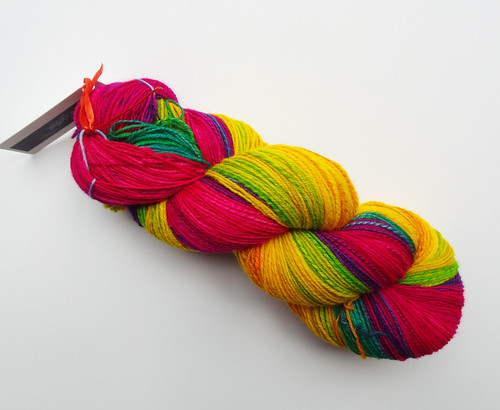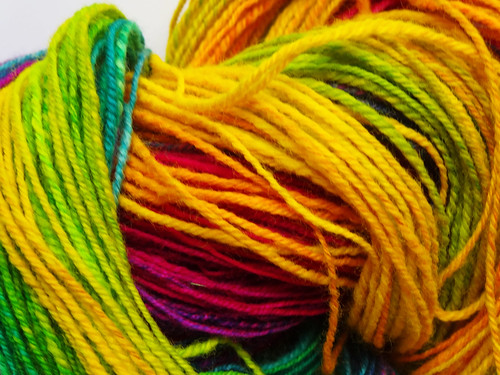Sometimes I get so excited about a project that I want to tell you all about it, even if it's completion is "out of order", so to speak. I generally like to talk about finished objects in the order that they are completed, as it makes it easier for me to keep track of what needs blogging about. But when I get a bit giddy over a project some things can get skipped over and then they fall through the blogging cracks. Then when I go to a project page on Ravelry for some reason and click on the blog post tab I suddenly realise that I missed blogging about it. This was one such project and it really deserves to be blogged about.
The bright yarn in question was dyed by one of my favourite UK dyers, Countess Ablaze. The fibre was 100% Superwash Merino in the Geeks Like Rainbows Too colourway. It was a gradient of the most vibrant and lovely colours.
I knew when I bought the fibre that I wanted to maintain that glorious gradient. It would seem so wrong to mix it all up, when it worked so perfectly like that. I put the fibre to one side whilst I finished some other projects and finally picked it up again, in order to take it on holiday with me to Suffolk. I knew I wanted to use my lovely Spanish Peacock spindle as it spins quickly and therefore makes it easier to spin a fine yarn. I wanted to make sure I made the single fine enough, that when it was chain plied I would have enough to make a shawl to show off those lovely colours. As I was going to spin finely, following the precise gradient, I knew I would be spinning worsted style in order to smoothly transition colours and also to add strength to the singles.
The fibre spun beautifully fine and it drafted very easily. It was the perfect holiday spinning as it required almost no concentration from me at all. It felt like it almost spun itself! When I reached the maximum cop size I slid the cop off onto another spindle for storage. The upside down cop definitely looked odd but I knew I wanted to maintain the order of the colour transitions.
When I finished spinning the other half of the fibre, I placed the spindles in my cheap plastic basket with holes and started to wind off the singles into a chain ply plying ball. I wound off the second cop first, followed by the first cop which meant the colour transitions were in the same order as it was dyed.
I put the twist in the rested chained singles and got a fairly even yarn.
I managed to spin 390m/426yds of a sock weight to heavy lace weight yarn. The majority of the yarn is a fingering weight, so it should work out well in a shawl pattern. The thinner parts will get hidden in the pattern.
I am quite proud that there is only a small degree of variation in the thickness of the yarn, as obviously chain plying a yarn magnifies any flaws in gauge. In chain plying, very fine parts of the singles are only plied against very fine parts singles, because it is being plied against itself. There is no averaging out of variations that you get in a true 3-ply yarn, where thick parts get plied with thin parts and so get evened out along the length of the yarn. This yarn proves I am getting more consistent in my spinning.
After plying I soaked the yarn, before squeezing with a towel and then snapping it to help align the fibres. I then hung it to dry. The finished yarn isn't very bouncy but it does have nice drape. It's not too rigid, which has happened before with my finer yarns.
I wanted to choose a shawl pattern that would show off the colour changes to the best of my ability, so I've paired this yarn up with a pattern from my queue, Antarktis by Janina Kallio. This pattern is knit on the bias starting at a point and working to a long edge, and it is customisable for the amount of yarn you have. I think it will make the gradient look gorgeous. I do like having patterns matched up with yarn. It makes it easier when I am looking for inspiration of what to knit next, especially with handspun yarn.





